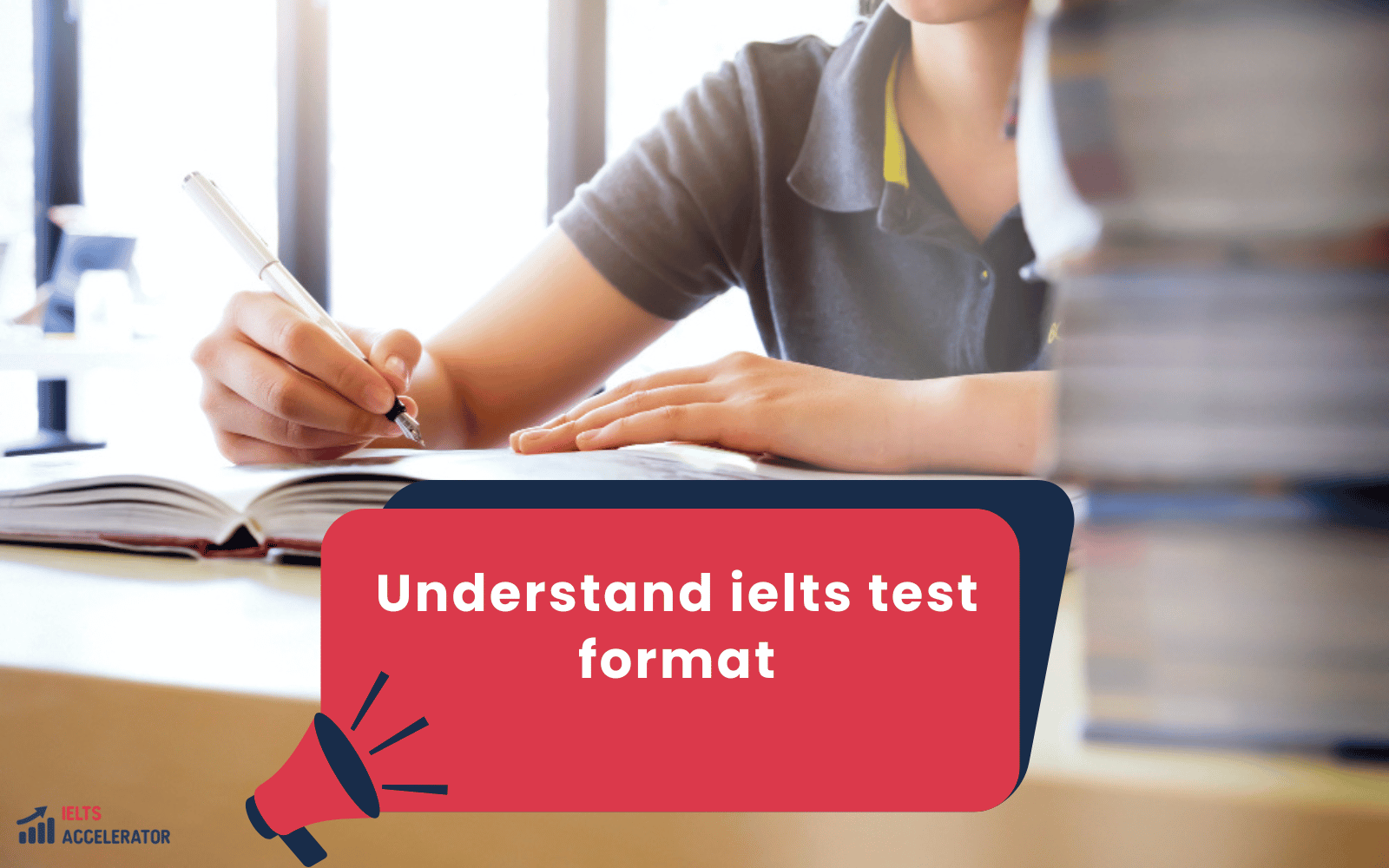The International English Language Testing System (IELTS) measures your listening, reading, writing, and speaking skills. Academic and General Training are the two types of IELTS tests. IELTS test format, content, level of difficulty, and scoring of General Training and Academic are similar. Both are graded in the same way. And while everyone takes the same Listening and Speaking tests, the Reading and Writing tests are different. Make sure you’re getting ready for the right type of test.
You can learn more about how each skill’s score is calculated Here.
You will take the listening, reading, and writing sections on the same day, one after the other, with no breaks.
Depending on local arrangements, your Speaking test will be held on the same day, or seven days before or after. The entire time for the test is 2 hours 44 minutes, plus 10 minutes for the transfer.
IELTS Listening Test:
The IELTS Listening test is used to evaluate a variety of listening capabilities. Including how effectively you understand main ideas and particular factual information, how well you recognize a speaker’s viewpoints, attitudes, and purpose, and follow the development of an argument.
You’ll listen to four recordings of native English speakers with different accents, and then answer a paper of questions in writing.
- Recording 1: a conversation between two people set in an everyday social context.
- Recording 2: a monologue set in an everyday social context, e.g., a speech about local facilities.
- Recording 3: a conversation between up to four people set in an educational or training context, e.g., a university tutor and a student discussing an assignment.
- Recording 4: a monologue on an academic subject, e.g., a university lecture.
The paper is divided into four sections, each with ten questions (Total: 40 questions). The answers to the questions are presented in the same order as they are heard in the audio.
The recordings are heard only once.
The total time is approximately 30 minutes (plus 10 minutes transfer time).
There are a variety of question types are used, as shown below:
You can learn more about how the listening skill score is calculated Here.
IELTS Reading Test:
The IELTS Reading test is used to evaluate a wide range of reading capabilities. Including how well you read for the overall sense of a passage, read for the main ideas, read for more details, comprehend hidden meaning and inferences, recognise a writer’s opinions, attitudes, and purpose and follow the progression of an argument.
You’ll have to read quickly and efficiently while still keeping track of your time. In the IELTS Reading test, you will be asked to read three different passages and respond to associated questions. The Reading section of the IELTS Academic and IELTS General Training examinations has different content.
IELTS Academic Reading Test:
You’ll have three different reading passages – which range from descriptive and factual to discursive and analytical – each with a different set of questions and task types (Total: 40 questions).
These quotations are from books, journals, magazines, and newspapers. They were chosen for a non-specialist audience, although they are also ideal for students starting university courses or seeking professional registration.
Test takers are required to transfer their answers to an answer sheet during the time allowed for the test. No extra time is allowed for transfer. Care should be taken when writing answers on the answer sheet, as poor spelling and grammar are penalized.
The total time is 60 minutes (including 10 minutes transfer time).
IELTS General Training Reading Test:
You’ll have three sections. Section 1 may contain two or three short texts or several shorter texts. Section 2 comprises two texts. In Section 3, there is one long text.
Extracts from books, magazines, newspapers, notices, advertisements, company handbooks, and guidelines. These are materials you are likely to encounter on a daily basis in an English-speaking environment.
Test takers are required to transfer their answers to an answer sheet during the time allowed for the test. No extra time is allowed for transfer. Care should be taken when writing answers on the answer sheet, as poor spelling and grammar are penalized (Total: 40 questions).
The total time is 60 minutes (including 10 minutes transfer time).
There are a variety of question types are used in both Academic and General Training Reading Test, as shown below:
You can learn more about how Reading skill score is calculated Here.
IELTS Writing Test:
The IELTS Writing test is designed to assess a wide range of writing skills, including how well you write a response appropriately, organize ideas, and use a range of vocabulary and grammar accurately.
IELTS Academic Writing Test:
There are two tasks to complete:
- Task 1: You will be given a graph, table, chart, or diagram and asked to describe, summarise, or explain it in your own words. You may be requested to describe and explain data, process phases, how something works, or a specific object or event.
- Task 2: you will be asked to write an essay in response to a point of view, argument or problem. Both tasks must be completed in a formal manner.
Answers must be written in full on the answer sheet. Answers in the form of notes or bullet points are not acceptable. Test takers are allowed to write on the question paper, but they cannot take it out of the room and the examiner will not see it (Total: 2 questions).
It takes 60 minutes to complete the IELTS Writing test. Task 1 should take 20 minutes, and Task 2 should take 40 minutes. You’ll need to keep track of your own time, so move on to Task 2 after 20 minutes.
A closer look at Academic Task 1 and Task 2 is shown below:
IELTS General Training Writing Test:
The topics are interesting to a wide range of people. There are two tasks to complete:
- Task 1: You will be given a situation and will be asked to write a letter asking for information or describing the circumstance. The letter might be written in a personal, semiformal, or formal tone.
- Task 2: Reply to a point of view, argument, or problem in an essay. In terms of style, the essay can be quite personal.
Answers must be written in full on the answer sheet. Answers in the form of notes or bullet points are not acceptable. Test takers are allowed to write on the question paper, but they cannot take it out of the room and the examiner will not see it (Total: 2 questions).
It takes 60 minutes to complete the IELTS Writing test. Task 1 should take 20 minutes, and Task 2 should take 40 minutes. You’ll need to keep track of your own time, so move on to Task 2 after 20 minutes.
A closer look at General Task 1 and Task 2 is shown below:
You can learn more about how writing skill score is calculated Here.
IELTS Speaking Test:
The speaking test consists of an oral interview between the test takers’ and an examiner. Every test is recorded.
Both the IELTS Academic and IELTS General Training examinations have the identical content as the IELTS Speaking test.
The IELTS Speaking test is used to evaluate a variety of skills.
The examiner will want to see how well you can communicate opinions and information about everyday topics and common experiences; to do so, you’ll have to answer a series of questions, speak at length on a given topic using appropriate language, organize your thoughts coherently, express and justify your opinions, and analyze, discuss, and speculate about issues.
Make sure you’re relaxed and speaking clearly. It will be necessary for you to speak in a natural manner.
The total time is 11-14 minutes.
The test is divided into three parts, each of which serves a specific purpose in terms of interaction pattern, task input, and test taker output.
IELTS Speaking Part 1:
The examiner will introduce himself or herself, and you will be asked to do the same to confirm your identity. The examiner will ask you general questions about your home, family, work, studies, and interests, among other topics. This part should help you in loosening and speaking naturally.
This part of the test assesses your ability to communicate thoughts and facts about ordinary topics, as well as common events or situations, by answering a series of questions.
IELTS Speaking Part 2:
The examiner will give you a task card on which you will be asked to speak about a certain topic and will be given points to include in your speech. One minute will be given to you to prepare and take notes. After that, you’ll be asked to speak for 1-2 minutes about the topic. Because you will not be interrupted during this time, it is important that you continue speaking. After then, the examiner will ask you one or two questions about the same topic.
This part of the test focuses on your ability to speak at length on a specific topic (without prompting from the examiner), use proper language, and organize your thoughts in a logical manner. It’s conceivable that test-takers will have to rely on their own experiences to finish the exam.
IELTS Speaking Part 3:
Additional questions related to the content of Part 2 will be asked by the examiner. These questions are meant to allow you to discuss more abstract concerns and ideas.
This part of the test focuses on your ability to explain and justify your thoughts as well as analyze, discuss, and hypothesize on issues.
You can learn more about how speaking skill score is calculated Here.Now with the IELTS accelerator, you can learn how to boost your score, pass the exam easily and achieve your desired score. Join Us Now.





